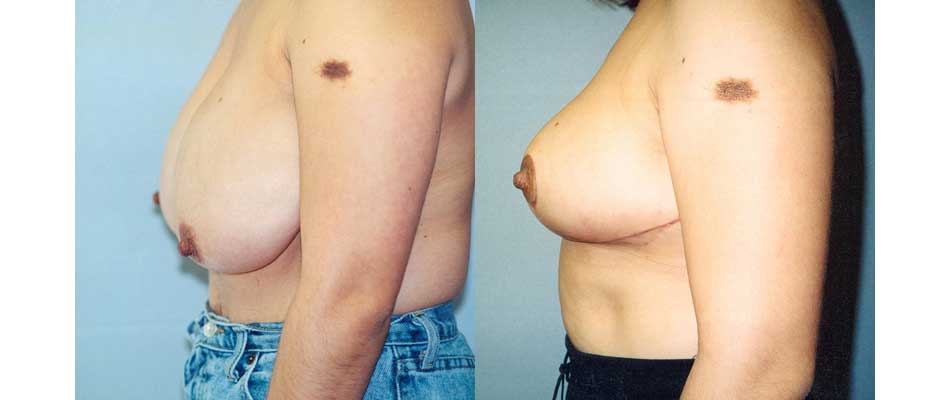Breast Reduction (Reduction Mammoplasty)
What is Breast Reduction?
Breast reduction is a common procedure to sculpt a breast size that is more proportionate to your body. During surgery, fat, tissue, and skin is removed from the breasts. It is also performed to reduce uncomfortable symptoms caused by very large breasts. Breast reduction surgery is also called reduction mammoplasty.
Large breasts that are disproportionate to the body, called macromastia, can cause physical symptoms and emotional distress. Breast reduction is often done to alleviate physical symptoms but is also commonly done for aesthetic reasons on women who are unhappy with their larger breast size.
Breast reduction can:
- Relieve physical symptoms caused by the weight of the breasts
- Help you lead a more active life
- Alleviate self-consciousness and emotional stress caused by social stigma about breast size
- Make clothing fit more comfortably
- Boost self-confidence
Good Candidates for Breast Reduction
Plastic surgery is a deeply personal and often emotional decision. Before scheduling a procedure, it’s important to carefully consider the benefits of the surgery and your reasons for considering breast reduction. You’ll be happiest with your results if the decision is yours alone and not made under pressure from anyone else.
Breast reduction may be an option if you:
- Are physically healthy
- Are not pregnant or breastfeeding
- Have realistic expectations
- Have fully developed breasts
- Are physically limited by the size of your breasts
- Feel like your breasts are too large for your comfort
- Have pain in your neck, shoulders, and back because of the weight of your breasts
- Have indentations in your shoulders from bra straps
- Have irritated under your breasts, in the crease
- Don’t smoke
Preparing for a Breast Reduction
At your consultation, your doctor will review your medical history, ask about your expectations, and discuss the risks and benefits of surgery. You’ll also have a physical exam.
Before surgery, you may need to:
- Get lab tests
- Have a baseline mammogram
- Stop smoking
- Stop taking or adjust certain medications
The Breast Reduction Procedure
The procedure may be done in an outpatient center or hospital.
- You may have general anesthesia or sedation.
- Your surgeon will make incisions. The locations may differ from case to case.
- The nipple will be repositioned and, if necessary, the size of the areola will be reduced.
- Breast tissue will be reduced, shaped, and lifted as needed.
- The incisions will be closed with sutures layered within the tissue to support the newly shaped breasts. You may have sutures, surgical tape, and/or skin adhesives, as well as tubes to drain excess fluid.
- You will rest in a recovery area until you are cleared to go home. Before leaving, your surgeon will talk to you about post-operative instructions and care.
You’ll notice the results of your reduction at once but won’t see the final size and shape until any swelling goes down.
Before you leave, you’ll be given critical post-surgical care instructions. It is essential that you follow these instructions carefully for your health and safety to achieve the best results.
Recovery
During your recovery period, it’s important to carefully follow your doctor’s instructions for caring for your breasts.
You’ll need to rest and avoid activity until your doctor tells you it’s safe to return to your normal activities.
You may have pain for the first few days after surgery and may have a prescription for pain medication. You should also expect to see some swelling and soreness for several weeks.
How much does breast reduction cost?
The cost of breast reduction varies. Your cost will depend on your doctor, the type of procedure, and your location.
Other breast reduction costs may include:
- Anesthesia fee
- Compression garments for after surgery
- Hospital costs
- Medical tests
- Prescriptions
- Surgeon’s fee
Many insurance plans cover breast reduction surgery. Some may require your surgeon to obtain authorization before surgery. Because you must pay for costs not covered by insurance, it’s important to understand your coverage before scheduling surgery.
Risks and Complications
Every surgery carries some risk. Your surgeon will explain the procedure and associated risks at your consultation.
It’s important to know that breast reduction can interfere with some diagnostic procedures and may limit your ability to breastfeed.
Possible risks include:
- Bleeding
- Blood clots
- Breast asymmetry
- Changes in sensation
- Excessive firmness
- Fat necrosis
- Fluid buildup
- Hematoma
- Infection
- Injury to nerves, blood vessels, or muscles
- Loss of skin or tissue
- Loss of nipple or areola
- Pain
- Poor healing or scarring
- Reactions to anesthesia
- Shape or contour irregularities
If you’re ready to feel better and look better, call Dr. Madry’s office today for a breast reduction consultation.
“I have thought of having a reduction for years. The pain in my neck and shoulders was getting worse every year. I finely said something to my PC and she is the one who told me the insurance might cover it…I was able to have my surgery before the end of the year. It was one of the best things I have ever done for myself. My only regret is that I waited so long!” – VP
Breast Reduction Before & After Photos
Case 1
Case 2
Case 3
Case 4
Case 5
Case 6
Case 7
Case 8
Case 9


























